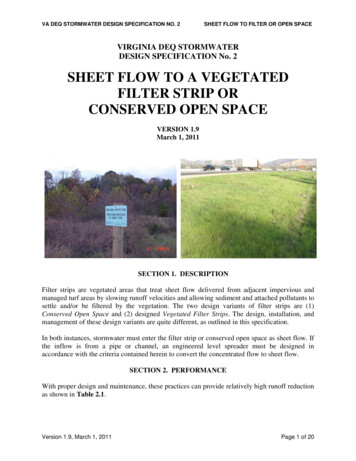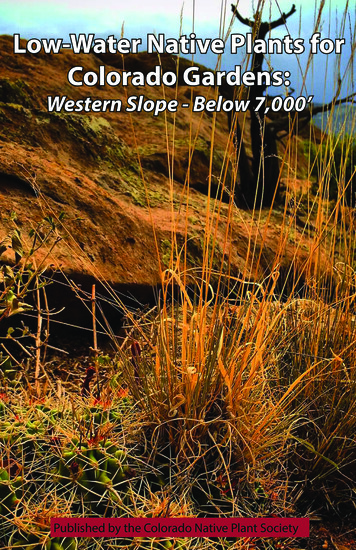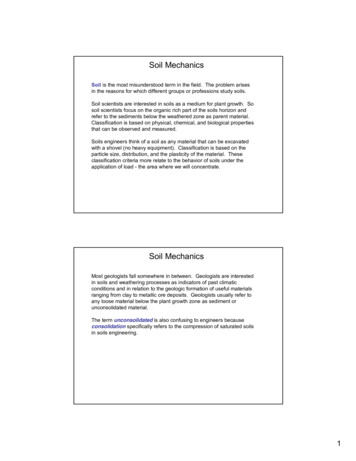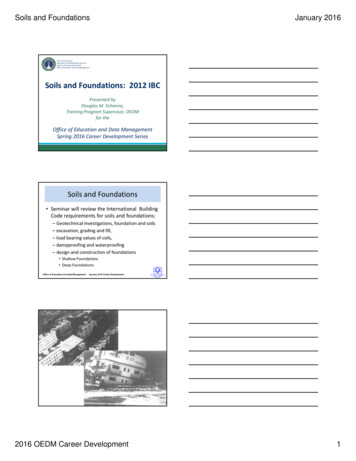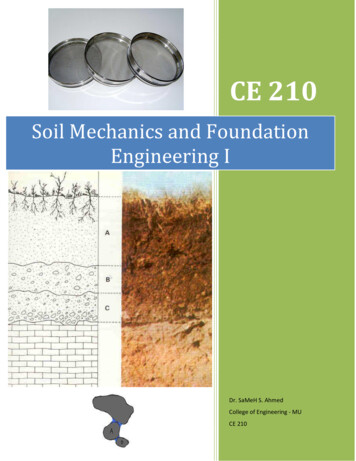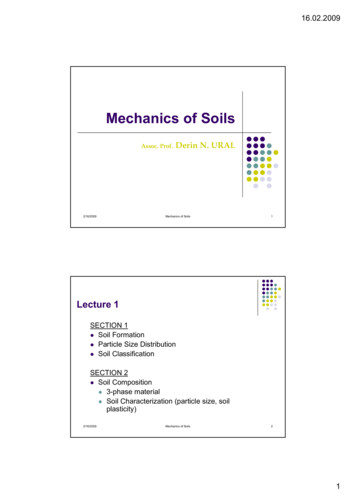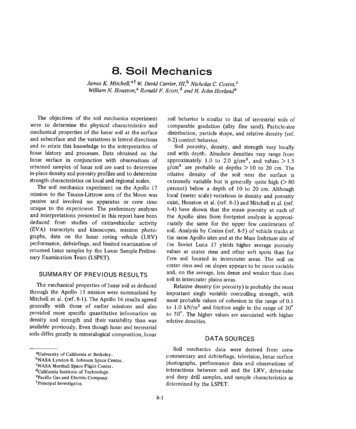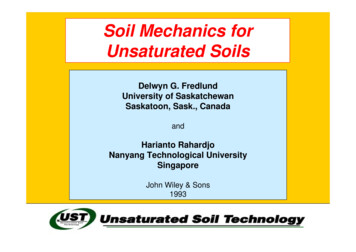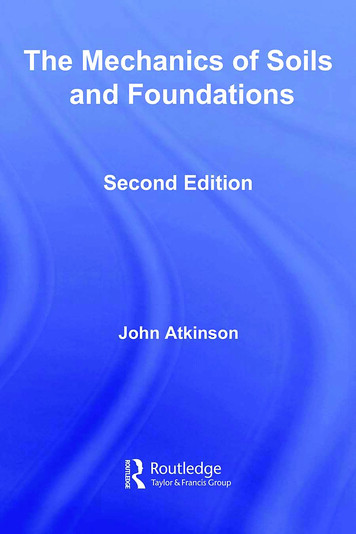
Transcription
The Mechanics of Soils and Foundations
Also available from Taylor & FrancisIntroductory Geotechnical EngineeringY.S. Fang et al.Geotechnical Engineering 2nd edR. LancellottaHb: ISBN 9780415304016Pb: ISBN 9780415304023Hb: ISBN 9780415420037Pb: ISBN 9780415420044Pile Design & Construction Practice 5th edM. Tomlinson et al.Hb: ISBN 9780415385824Piling EngineeringW.G.K. Fleming et al.Hb: ISBN 9780415266468Foundations of Geotechnical EngineeringI. Jefferson et al.Hb: ISBN 9780415272407Pb: ISBN 9780415272414Decoding Eurocode 7A. Bond et al.Hb: ISBN 9780415409483Geotechnical Physical ModellingC. Leung et al.Hb: ISBN 9780415420174Information and ordering detailsFor price availability and ordering visit our website www.tandfbuiltenvironment.com/Alternatively our books are available from all good bookshops.
The Mechanics of Soilsand FoundationsSecond EditionJohn Atkinson
First published 1993 by McGraw-HillSecond edition published 2007 by Taylor & Francis2 Park Square, Milton Park, Abingdon, Oxon OX14 4RNSimultaneously published in the USA and Canadaby Taylor & Francis270 Madison Avenue, New York, NY 10016, USATaylor & Francis is an imprint of the Taylor & Francis Group, an informa businessThis edition published in the Taylor & Francis e-Library, 2007.“To purchase your own copy of this or any of Taylor & Francis or Routledge’scollection of thousands of eBooks please go to www.eBookstore.tandf.co.uk.” 2007 John AtkinsonAll rights reserved. No part of this book may be reprinted or reproduced orutilised in any form or by any electronic, mechanical, or other means, now knownor hereafter invented, including photocopying and recording, or in anyinformation storage or retrieval system, without permission in writing from thepublishers.The publisher makes no representation, express or implied, with regard to theaccuracy of the information contained in this book and cannot accept any legalresponsibility or liability for any efforts or omissions that may be made.British Library Cataloguing in Publication DataA catalogue record for this book is available from the British LibraryLibrary of Congress Cataloging-in-Publication DataAtkinson, J.H.The mechanics of soils and foundations/John Atkinson. – 2nd ed.p. cm.Includes bibliographical references and Index.ISBN 978-0-415-36256-6 (alk. paper) – ISBN 978-0-415-36255-9 (alk. paper)1. Soil mechanics. 2. Foundations. 3. Slopes (Soil mechanics) I. Title.TA710.A786 2007624.1 5–dc222006049709ISBN 0-203-01288-7 Master e-book ISBNISBN 10: 0-415-36255-5 (hbk)ISBN 10: 0-415-36256-3 (pbk)ISBN 10: 0-203-01288-7 (ebk)ISBN 13: 978-0-415-36255-9 (hbk)ISBN 13: 978-0-415-36256-6 (pbk)ISBN 13: 978-0-203-01288-8 (ebk)
ContentsPreface to the 1st editionPreface to the 2nd editionA note on unitsGreek alphabetGlossary of symbolsSome simple experiments to illustrate geotechnical engineering1Introduction to geotechnical engineering1.11.21.31.41.51.61.71.81.921What is geotechnical engineering? 1Principles of engineering 3Fundamentals of mechanics 3Material behaviour 4Basic characteristics of soils 7Basic forms of geotechnical structure 7Factors of safety and load factors 8Standards and codes of practice 10Summary 10Further reading 11Basic ixxviIntroduction 12Stresses and strains 12Plane strain and axial symmetry 14Rigid body mechanics 14Analysis of stress 16Analysis of strain 16Stress ratio and dilation 18Slip surfaces 20Summary 21Worked examples 21Further reading 2312
vi3ContentsEssentials of material 53Description and classification 53Description of soils 53Soil particle sizes, shapes and gradings 54Properties of fine-grained soils 56Specific volume, water content and unit weight 57Limits of consistency 58Current state 60Origins of soils 61Summary 62Worked examples 62References 65Further reading 65Pore pressure, effective stress and drainage6.16.26.344Introduction 44The Earth’s crust 44Geological processes 46Stratigraphy and the age of soils and rocks 46Depositional environments 47Recent geological events 50Importance of geology in geotechnical engineering 52Further reading 52Classification of soils5.15.25.35.45.55.65.75.85.96Stress–strain behaviour, stiffness and strength 24Choice of parameters for stress and strain 25Strength 28Brittle and ductile 30Stiffness 31Strength, stiffness and rigidity 32Constitutive equations 33Elasticity 34Perfect plasticity 35Combined elasto–plastic behaviour 37Time and rate effects 41Summary 42Worked examples 42Further reading 43The structure of the Earth4.14.24.34.44.54.64.724Introduction 66Stress in the ground 66Groundwater and pore pressure 6766
118105Introduction 105Isotropic compression and swelling 105Overconsolidation and yield stress ratio 108State of soils on the wet side and on the dry side of critical 110One-dimensional compression and swelling 112Horizontal stress in one-dimensional loading 114Summary 116Worked examples 116Further reading 118Critical state strength of soil9.19.29.39.49.59.685Purposes of laboratory tests 85Standard tests and specifications 86Basic classification tests 86Measurement of coefficient of permeability 88Principal features of soil loading tests 90One-dimensional compression and consolidation(oedometer) tests 92Shear tests 92Conventional triaxial compression tests 93Hydraulic triaxial cells – stress path tests 96Comments on soil testing 98Summary 99Worked examples 99Further reading 104Compression and swelling8.18.28.38.48.58.68.79Suctions in saturated soil 68Effective stress 70Importance of effective stress 71Demonstrations of effective stress 72Volume change and drainage 74Drained loading, undrained loading and consolidation 75Rates of loading and drainage 77Summary 79Worked examples 79Reference 84Laboratory testing of soils7.17.27.37.47.57.6viiBehaviour of soil in shear tests 119Peak, critical state and residual strengths 121Critical states 122Undrained strength 124Total and effective stress analyses 126Normalizing 126119
viiiContents9.79.89.99.109.119.1210Peak ction 161Wet side and dry side of critical 161State boundary surface for soil 164Elastic behaviour at states inside the state boundary surface 166Soil behaviour during undrained loading 168Stress ratio and dilation 170Slip planes and apparent errors in test results 171Summary 173Worked examples 173Reference 176Further reading 176Cam clay12.112.212.312.412.5142Introduction 142Mohr–Coulomb line for peak strength in shear tests 142Mohr–Coulomb line for peak strength in triaxial tests 146A power law equation for peak strength 147Peak states and dilation 150Comparison between the Mohr–Coulomb and thestress–dilatancy theories 154Relationship between peak strength and stateparameter 155Summary 156Worked examples 157Reference 160Further reading 160Behaviour of soil before failure11.111.211.311.411.511.611.711.812Critical state strength of soils measured in triaxial tests 127Relationships between strength measured in shear andtriaxial tests 132State and state parameters 132Simple experimental investigations of critical states 134True cohesion in soils 136Summary 136Worked examples 137References 141Further reading 141Introduction 177Basic features of the Cam clay models 177State boundary surface for ordinary Cam clay 178Calculation of plastic strains 181Yielding and hardening 181177
ater conditions 201Practical problems of groundwater flow 202Essentials of steady state seepage 204Flow through a simple flownet 206Flownet for two-dimensional seepage 208Piping and erosion 210Seepage through anisotropic soils 211Summary 211Worked examples 212Further reading n 187Cam clay and soil stiffness 187Stiffness–strain relationships for soil 188Strains in the ground 191Measurement of soil stiffness in laboratory tests 192Stiffness of soil at small and very small strains 193Rigidity and non-linearity 196Numerical modelling of soil stiffness 198Summary 199References 200Further reading 200Steady state seepage14.114.214.314.414.514.614.714.815Complete constitutive equations for ordinary Cam clay 183Applications of Cam clay in design 184Summary 184Worked examples 185References 185Further reading 186Stiffness of soil13.113.213.313.413.513.613.713.813.9ixBasic mechanism of consolidation 215Theory for one-dimensional consolidation 215Isochrones 218Properties of isochrones 218Solution for one-dimensional consolidation by parabolicisochrones 220Other consolidation solutions 224Determination of cv from oedometer tests 224Continuous loading and consolidation 226Summary 228Worked examples 229References 231215
x16ContentsNatural soils23216.1 Characteristics of natural soils 23216.2 One-dimensional compression and swelling of soilsin the ground 23316.3 Changes of state and yield stress ratio in natural soils 23516.4 Effects of volume changes due to vibration or creep 23616.5 Influence of layering in sedimented soils 23816.6 Influence of bonding and weathering 23816.7 Changes in pore water salinity 24016.8 Summary 241References 241Further reading 24117Ground .518.618.718.818.918.1018.1119Introduction 242Objectives of ground investigations 242Planning and doing investigations 244Test pitting, drilling and sampling 245In situ testing 247Investigating groundwater and permeability 249Ground investigation reports 251Summary 253References 254Further reading 254Soil parameters for design18.118.218.318.4242255Introduction 255Principles of design 255Description and classification 257Drained or undrained or consolidation: total or effectivestress parameters 257Ultimate limit state: critical state and residual strengthsand factors of safety 259Serviceability limit state: peak strength with a load factor 262Serviceability limit state: soil stiffness and design loads 263Parameters related to description and classification 265States of soils in the ground 267Accounting for variability 268Summary 269References 270Ultimate stability of soil structures using bound methods19.1 Introduction 27119.2 Factors 272271
s of plastic collapse 272Compatible mechanisms of slip surfaces 274Work done by internal stresses and external loads 275Simple upper bounds for a foundation 278Discontinuous equilibrium stress states 279Simple lower bounds for a foundation 283Upper and lower bound solutions using fans 284Bound solutions for the bearing capacity of a foundationfor undrained loading using fans 29019.11 Bound solutions for the bearing capacity of a foundationfor drained loading using fans 29219.12 Summary 295Worked examples 295Further reading 30220Limit equilibrium method30320.120.220.320.420.5Theory of the limit equilibrium method 303Simple limit equilibrium solutions 304Coulomb wedge analyses 306Simple slip circle analyses for undrained loading 310Slip circle method for drained loading – the methodof slices 31020.6 Other limit equilibrium methods 31420.7 Limit equilibrium solutions 31620.8 Summary 316Worked examples 316References 321Further reading 32121Stability of 11Introduction 322Types of instability 322Parameters and factors for design of slopes 324Stress changes in slopes 325Influence of water on stability of slopes 328Stability of infinite slopes 330Influence of seepage on the stability of infiniteslopes 336Stability of vertical cuts 337Routine slope stability analyses 340Behaviour of simple excavations 342Summary 343Worked examples 343References 344Further reading 344322
xii22ContentsBearing capacity and settlement of shallow foundations34522.1 Types of foundations 34522.2 Foundation behaviour 34722.3 Soil strength parameters and factors for design of shallowfoundations 34822.4 Stress changes in foundations 35022.5 Bearing capacity of shallow foundations 35122.6 Foundations on sand 35422.7 Combined vertical and horizontal loading on shallowfoundations 35422.8 Foundations in elastic soil 35622.9 Parameters for elastic analyses 35922.10 Consolidation settlements for one-dimensional loading 36022.11 Heave and settlement of foundations due to changesof groundwater 36222.12 Summary 364Worked examples 365References 368Further reading 36823Piled foundations23.123.223.323.423.523.624Types of piled foundations 369Base resistance of single piles 371Shaft friction on piles 372Pile testing and driving formulae 373Capacity of pile groups 374Summary 375References 376Further reading 376Earth pressures and stability of retaining 1369Introduction 377Earth pressures 377Types of retaining structure 378Failure of retaining walls 378Stress changes in soil near retaining walls 379Influence of water on retaining walls 383Calculation of earth pressures – drained loading 384Calculation of earth pressures – undrained loading 386Overall stability 387Soil strength and factors for design of retaining walls 391Summary 393Worked examples 393Further reading 396377
Contents25Tunnelling in soft roduction 408Occurrence of unsaturated soils 408Degree of saturation and specific volume 408Distribution of air and water in unsaturated soil 410Pore pressure and suction in unsaturated soil 411Desaturation and water retention 411Undrained loading of unsaturated soil 413Strength of unsaturated soil in slope stability 413Settlement of foundations on unsaturated soil 414Compaction and compacted soils 415Compaction curves and behaviour of compacted soil 416Summary 417Further reading 417Geotechnical centrifuge modelling27.127.227.327.427.527.627.7397Tunnel construction 397Construction of bored tunnels in soft ground 397Stress changes near tunnels 399Stability of tunnel headings 400Influence of water on tunnels 403Ground movements due to tunnelling 404Load factors to limit ground movements 406Summary 407References 407Further reading 407Behaviour of unsaturated 126.12xiii418Modelling in engineering 418Scaling laws and dimensional analysis 418Scaling geotechnical models 419Purposes of modelling 422Geotechnical centrifuges 423Control and instrumentation in centrifuge models 424Summary 425Reference 425Further reading 425Concluding remarks427Author IndexSubject Index429431
Preface to the 1st editionThis book is about the behaviour of engineering soils and simple geotechnical structures such as foundations and slopes and it covers most of the theoretical geotechnicalengineering content of a degree course in civil engineering. The book is aimed primarilyat students taking first degree courses in civil engineering but it should also appeal toengineers, engineering geologists and postgraduate students wishing for a simple andstraightforward introduction to the current theories of soil mechanics and geotechnicalengineering. Although it deals specifically with soils and soil mechanics many of thetheories and methods described apply also to rocks and rock mechanics.The teaching and practice of geotechnical engineering has undergone significantchanges in the past 25 years or so, both in the development of new theories and practicesand in the standing of the subject within the civil engineering curriculum. Geotechnicalengineering is now regarded as one of the major disciplines in civil engineering analysis(the others being hydraulics and structures). The most important development, however, has been the unification of shearing and volumetric effects in soil mechanics inthe theories known generally as critical state soil mechanics and application of thesetheories in geotechnical analysis. In this book, unlike most of the other contemporarybooks on soil mechanics, the subject is developed using the unified theories right fromthe start, and theories for stability of foundations and slopes are developed through theupper and lower bound plasticity methods as well as the more commonly used limitequilibrium method. This is an up-to-date approach to soil mechanics and geotechnical engineering and it provides a simple and logical framework for teaching the basicprinciples of the subject.The term ‘critical state soil mechanics’ means different things to different people.Some take critical state soil mechanics to include the complete mathematical modelknown as Cam Clay and they would say that this is too advanced for an undergraduatecourse. My view is much simpler, and by critical state soil mechanics I mean the combination of shear stress, normal stress and volume into a single unifying framework.In this way a much clearer idea emerges of the behaviour of normally consolidated andoverconsolidated soils during drained and undrained loading up to, and including, theultimate or critical states. It is the relationship between the initial states and the criticalstates that largely determines soil behaviour. This simple framework is extremely useful for teaching and learning about soil mechanics and it leads to a number of simpleanalyses for stability of slopes, walls and foundations.This book is based on courses of lectures given to undergraduate students in civilengineering at City University. In the first year students take a course in geology and
Preface to the 1st editionxvthey also take a course in mechanics of materials within which there are six to eightlectures on soil mechanics and geotechnical engineering. These lectures cover the wholeof the conventional syllabus (classification, seepage, strength, consolidation, bearingcapacity and settlement, slope stability and earth pressure) but at lightning speed. Theobject is to introduce the students to the concepts and vocabulary of geotechnicalengineering within the context of conventional mechanics of materials and structuresand with reference to their everyday, childhood experiences of playing with sand, flour,plasticine and other soil-like materials so that, as the course develops in later years,they can relate particular topics into the whole scheme of civil engineering.In the second year the students take a major course of lectures (with several laboratory sessions) in theoretical soil mechanics and geotechnical engineering. This is basedon my earlier books – The Mechanics of Soils (with Peter Bransby) and Foundationsand Slopes. This course depends entirely on the unification of shearing and volumetriceffects which is introduced right from the start (and had been in the first year), althoughthe phrase ‘critical state soil mechanics’ is rarely used. Theoretical soil mechanics istaken up to the development of a complete state boundary surface but stops short ofthe mathematical treatment of Cam clay. Stability problems are solved using upper andlower bound methods and these are then used to introduce limit equilibrium methodsand standard tables and charts for bearing capacity, slope stability and earth pressure.In the third year the course covers practical aspects of geotechnical engineering througha series of lectures and projects on topics such as ground investigation, foundations,slopes, retaining walls and embankment designs.This book covers the material in the second-year course (and also that summarizedin the first year). It does not deal specifically with the practical aspects of geotechnicalengineering which are introduced in the third year and are, in any case, generally betterlearned through working in practice with experienced engineers. This book shouldprovide the basic text for an undergraduate course, but students will have to consultother books and publications to find more detailed coverage of particular topics suchas laboratory testing, seepage, slope stability and foundation design.The treatment of soil mechanics and geotechnical engineering in this book is simple,straightforward and largely idealized. I have tried to relate the behaviour of soilsand geotechnical structures to everyday experiences, encouraging students to performsimple experiments themselves at home, on holiday and in a basic soil mechanicslaboratory. I have described some simple tests which are designed to demonstrate thebasic principles rather than generate highly accurate results. Only a few details aregiven of the apparatus and procedures since engineers should be trained to design andbuild simple equipment and work out how to make observations and analyse resultsthemselves.To illustrate the basic nature of soil strength and stiffness I have described thebehaviour of soils in oedometer tests and in ideal shear tests in order to separate theeffects of normal stress and compression from the effects of shearing and distortion.I have also described the behaviour of soils in triaxial tests, as these are the best tests toevaluate soil parameters. Readers will notice that I have not included data from tests onreal soils or case histories of construction performance. This is quite deliberate and iscommon practice in undergraduate texts on structures, hydraulics, concrete and so on.As the book is intended primarily as an undergraduate teaching text it is kept simpleand straightforward. The basic soil mechanics theories have been clearly demonstrated
xviPreface to the 1st editionin earlier books from Critical State Soil Mechanics by Schofield and Wroth in 1968 toSoil Behaviour and Critical State Soil Mechanics by Muir Wood in 1991, and almosteverything in this book follows from these well-established theories.Throughout I have dealt with simple theories and idealizations for soil behaviour.I am very well aware that many natural soils behave in ways that differ from theseidealizations and that there are a number of additional factors that may influence thedesign and analysis of geotechnical structures. Nevertheless, I am convinced that for thepurposes of teaching the fundamental principles to students, it is better to maintainthe simplicity of the idealized treatment, provided always that they appreciate thatit is idealized. At many points in the text I have indicated where the behaviour ofvarious natural soils may depart significantly from the idealized behaviour. I expectthat individual lecturers will bring in other examples of the behaviour of natural soilsdrawn from their own experiences, but I hope that they would discuss these within thesimple framework described in this book.At the end of most chapters there is a short summary of the main points covered inthe chapter and, in most cases, simple worked examples and exercises that illustratethe theories developed in the text. There is also a short selection of books and articlesfor further reading and a list of specific references quoted in the text.The courses at City University which form the basis of this book were developedjointly with my colleagues Neil Taylor, Matthew Coop and John Evans and I amgrateful to them for their contributions and for their comments and criticisms. I amgrateful also for the very detailed comments that I received from many friends and colleagues, including Mark Allman, Eddie Bromhead, Peter Fookes, Charles Hird, MarcusMatthews, Sarah Stallebrass and Giulia Viggiani. The typing was shared betweenAnne-Christine Delalande and Robert Atkinson.John AtkinsonCity UniversityLondon
Preface to the 2nd editionThe first edition of The Mechanics of Soils and Foundations was published in 1993.Its objectives were set out in the Preface to the 1st edition and in the final chapter andthey were, I think, largely achieved. It was not, and was not intended to be, a guideto ground engineering: it contained few design charts, few references to standardsand codes and no case histories. It has been widely used as an undergraduate andpost-graduate text in the more up-to-date university courses in soil mechanics andgeotechnical engineering in UK and abroad. Teachers and students liked the very simpletreatments of the basic theories of soil mechanics and their applications in analyses ofslopes, foundations and retaining walls. Most of the engineers’ offices I have been inhave a copy.When Tony Moore of Taylor & Francis approached me to prepare a second editionmy initial response was say that I was very happy with the book as it was and couldn’the simply re-print it. It dealt with basic principles, little had changed in the time sincethe first edition was published and it was not therefore outdated. However, as I read itagain in detail I saw that there were bits missing and there were places where I had notexplained things as clearly as I would have liked. So this 2nd edition contains somenew material and it includes extensive re-working and clarifications of the originaldescriptions and explanations; I hope to make them clearer.I have added three new chapters. In the chapter on design parameters I have discussedwhich strengths, peak, critical state or residual, should be used with different analysesand with what factors. I have distinguished more clearly than before between a factorof safety which is intended to ensure that the structure is safe and a load factor which isintended to limit movements. I have related the basic strength and stiffness parametersof a soil to its classification. I have added a short chapter on unsaturated soils whichdescribes the relationships between soil, water and air and aspects of the behaviourof unsaturated soils. I have added a chapter on soft ground tunnelling because this isan important part of modern ground engineering and the current theories and designmethods illustrate the development of practice from a number of different methods ofresearch.As in the 1st edition, I have given a few charts of design parameters for slopes andfoundations to illustrate the more common ones. This is a teaching text-book and itdescribes the basic theories upon which these charts are based. It is not a design manualand I have deliberately made these charts small so you will not be able to obtain reliablevalues from them. If you are designing a slope, a foundation or a retaining wall youshould go to the original design charts or calculate the values you need.
xviiiPreface to the 2nd editionI have described some simple experiments which you can do yourself at home or atthe beach. These investigate the nature and state of soils and the behaviour of simpleslopes and foundations and there are links to the parts of the book which deal with therelevant theories. It is important always to relate the behaviour of these simple modelsto the theories you are taught at university and to the designs you will do in practice.I am grateful to all those friends and colleagues who have discussed with me soilmechanics and geotechnical engineering and how it should be taught to students.My belief is that university students should know and understand the basic principles which are described in my book. Applications of these theories through standardsand codes should be taught only when sufficient time has been given to establishingthe basic principles; practice is better learned by practice.I am grateful for the very detailed comments and criticisms that I received from EddieBromhead, Federica Coteccia, Andrew McNamara, Sarah Stallebrass, Neil Taylor andDave White who introduced me to the problem of the car going up hill which I haveused in Chapter 22. I am grateful to my colleagues at City University for allowing methe time to complete this new edition.John AtkinsonCity UniversityLondon
A note on unitsThe SI system of units has been used: the basic units of measurement n1 kN 103 N1 MN 106 NSome useful derived units are:VelocityAccelerationStress (pressure)Unit weightm/sm/s2kN/m2 kiloPascal kPakN/m3Unit force (1 N) gives unit mass (1 kg) unit acceleration (1 m/s2 ). The acceleration dueto the Earth’s gravity is g 9.81 m/s2 ; hence the force due to a mass of 1 kg at reston Earth is 9.81 N. (Note: there are about 10 apples in 1 kg: hence a stationary applegives rise to a force of about 1 N acting vertically downwards.)
Greek alphabetAs in most branches of science and engineering, geotechnical engineering uses mathematics and symbols to develop general theories. Because the English alphabet has alimited number of characters use is made of the Greek alphabet:AB EZHIK MN O P TY amunuxiomicronpirhosigmatauupsilonphichipsiomega
Glossary of symbolsStress and strain parametersOne-dimensional compression and shear tests:τ shear stressσ normal stressγshear strainεv volumetric strain normal strainTriaxial tests:q (σa σr )p 13 (σa 2σr )εs 23 (εa εr )εv εa 2εrdeviatoric stressmean normal stressshear strainvolumetric strainSuperscripts for strainse elasticp plasticSubscripts for states0 initial state(i.e. q 0 , p 0 , v0 )f critical state (i.e. q f , p f , vf )p peak state(i.e. q p , p p , vp )y yield(i.e. p y )r residualSubscripts for axesz, h vertical and horizontala, r axial and radialNormalizing parametersln p c ( v)/λvλ v λ ln p log σc (e e)/Cceλ e Cc log σ
xxiiGlossary of symbolsAABBBCCCcCsDDrEEFFaFnFsFsGGp , HpG oGsHHHHcIlIPIσIρJK K0KaKpLLfM NNc , Nγ , NqNdNfNsPPPPaareaactivitybreadth or widthparameter for peak state power law envelopepore pressure parametercompliancecover (above tunnel)slope of the normal compression lineslope of a swelling and recompression linedepthrelative densitywork done by external loadsYoung’s modulus (E for effective stress; Eu for undrained loading)forceaxial forcenormal forceshear forcefactor of safetyshear modulus (G for effective stress; Gu for undrained loading)parameters for peak strength in triaxial testsshear modulus at very small strainspecific gravity of soil grainsheight or thicknessmaximum drainage pathhorizontal load (on a foundation)critical height (of a slope)liquidity
13 Stiffness of soil 187 13.1 Introduction 187 13.2 Cam clay and soil stiffness 187 13.3 Stiffness–strain relationships for soil 188 13.4 Strains in the ground 191 13.5 Measurement of soil stiffness in laboratory tests 192 13.6 Stiffness of soil at small and v

